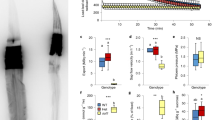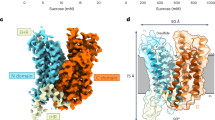Abstract
FOR plants to grow, sugars and other assimilates must constantly be transported from the leaves to the growing or storage regions. This essential transport function takes place in the highly specialised phloem tissue which consists of a network of interconnecting sieve tubes. In spite of its obvious agronomic importance, little is known about the first step of sugar entry (loading) into the sieve tubes. Here I propose a model which formulates several of the established, but difficult to reconcile, characteristics of the sieve tubes into a unifying model for sugar uptake. These characteristics include the alkaline sap1 (pH 8–8.5) with a high potassium ion and ATP2 concentration, the presence of electrical gradients3 and the considerable ATPase4 activity of the sieve tube plasmalemma. According to this model, sucrose leaves the site of synthesis in the mesophyll cells and enters the free space or apoplast which has a pH of 5 to 6. The sucrose is then accumulated into the alkaline sieve tubes by an active process involving membrane sulph-hydryl groups5. In this model the proton gradient of nearly 3 pH units across the sieve tube plasmalemma provides the driving force for sucrose uptake (Fig. 1). Based on non-electrolyte transport studies in bacteria6, algae7 and fungi8 it is proposed that protons are cotransported with sucrose into the sieve tubes.
This is a preview of subscription content, access via your institution
Access options
Subscribe to this journal
Receive 51 print issues and online access
$199.00 per year
only $3.90 per issue
Buy this article
- Purchase on Springer Link
- Instant access to full article PDF
Prices may be subject to local taxes which are calculated during checkout
Similar content being viewed by others
References
Hall, S. M. & Baker, D. A. Planta 106, 131–140 (1972).
Gardner, D. C. J. & Peel, A. J. Nature 222, 774 (1969).
Spanner, D. C. Nature 232, 157–160 (1971).
Yapa, P. A. J. & Spanner, D. C. Planta 117, 321–328 (1974).
Giaquinta, R. Pl. Physiol. 57, 872–875 (1976).
West, I. & Mitchell, P. J. Bioenerg. 3, 445–462 (1972).
Komor, E. & Tanner, W. Eur. J. Biochem. 44, 219–223 (1974).
Slayman, C. L. & Slayman, C. W. Proc. natn. Acad. Sci. U.S.A. 71, 1935–1939 (1974).
Giaquinta, R. Pl. Physiol. 59 (in the press).
Author information
Authors and Affiliations
Rights and permissions
About this article
Cite this article
GIAQUINTA, R. Possible role of pH gradient and membrane ATPase in the loading of sucrose into the sieve tubes. Nature 267, 369–370 (1977). https://doi.org/10.1038/267369a0
Received:
Accepted:
Issue Date:
DOI: https://doi.org/10.1038/267369a0
This article is cited by
-
Sucrose Transport into Plasma Membrane Vesicles from Tobacco Leaves by H+ Symport or Counter Exchange Does not Display a Linear Component
Journal of Membrane Biology (2004)
-
Role of thiourea in improving productivity of wheat (Triticum aestivum L.)
Journal of Plant Growth Regulation (1995)
-
Sugar transport across the plasma membranes of higher plants
Plant Molecular Biology (1994)
-
The proton-sucrose symport
Photosynthesis Research (1992)
-
Glass microelectrode measurements of sieve tube membrane potentials in internode discs and petiole strips of tomato (Solanum lycopersicum L.)
Protoplasma (1989)
Comments
By submitting a comment you agree to abide by our Terms and Community Guidelines. If you find something abusive or that does not comply with our terms or guidelines please flag it as inappropriate.



